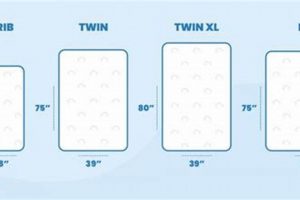A common decision faced by outdoor enthusiasts involves selecting a suitable sleeping surface for camping. This choice frequently narrows down to two primary options: a raised, framed bed designed for portability, or an inflatable sleeping pad that conforms to the user’s body. Both serve the fundamental purpose of providing a comfortable place to rest while mitigating direct contact with the ground.
The implications of this selection extend beyond mere comfort. Factors such as insulation from ground chill, ease of transportation and setup, durability in varying environmental conditions, and overall ergonomic support significantly impact the camping experience. Historically, simpler ground pads were the norm, but advancements in materials and design have led to more sophisticated and comfortable alternatives.
This exploration will delve into a detailed comparison of these two options, analyzing their respective advantages and disadvantages across key criteria. The goal is to provide readers with the information needed to make an informed decision based on their individual needs, preferences, and the specific demands of their camping trips. Detailed analysis of comfort level, portability, setup process, durability, temperature regulation and cost will be presented in subsequent sections.
Considerations for Sleeping Surface Selection
Selecting the appropriate sleeping arrangement significantly affects the overall camping experience. Careful consideration of several factors is crucial to ensure comfort and adequate rest in the outdoors.
Tip 1: Assess Environmental Conditions: Anticipate weather conditions expected during the camping trip. A raised bed may offer better insulation from cold ground temperatures, while an inflatable pad might be more suitable for warmer climates due to its lower profile.
Tip 2: Evaluate Portability Requirements: Analyze the available transportation space and weight restrictions. Folding beds generally require more storage space and are heavier than deflated pads. Choose the option that aligns with vehicle capacity and physical capabilities.
Tip 3: Determine Setup Complexity: Factor in the ease and speed of assembly. Some raised beds require more time and effort to set up compared to inflating a pad. Consider personal physical limitations and the desire for a quick campsite setup.
Tip 4: Prioritize Comfort Preferences: Reflect on individual sleeping preferences. Individuals who prefer a firmer surface may find raised beds more appealing, while others may prefer the conforming support of an inflatable pad.
Tip 5: Analyze Durability Expectations: Assess the terrain and potential risks of damage. Raised beds are generally more resistant to punctures, while inflatable pads are susceptible to damage from sharp objects. Employ protective measures to extend the lifespan of either option.
Tip 6: Budgetary Constraints: Compare the initial cost and potential long-term expenses. While some raised beds might have a higher upfront investment, inflatable pads could require replacement due to punctures or leaks. Balance initial investment with potential maintenance costs.
Understanding the nuances of each option empowers individuals to make informed choices, leading to more restful and enjoyable camping experiences. Ultimately, the most suitable sleeping arrangement depends on a careful evaluation of personal needs and environmental circumstances. Considerations discussed will allow for the user to have the most comfortable and practical camping experience.
1. Portability and Weight
The considerations of portability and weight are paramount when choosing between a camping cot and an air mattress. These factors directly influence the ease of transportation and setup, especially for campers who prioritize mobility or face limitations in storage space.
- Packed Size and Volume
Camping cots, due to their rigid frames, typically have a larger packed size compared to air mattresses. This increased volume can pose challenges for vehicle storage and may necessitate larger backpacks for transport. Air mattresses, when deflated, compress to a significantly smaller volume, offering greater flexibility in packing and carrying.
- Total Weight Burden
The weight differential between the two options is often substantial. Camping cots, constructed from metal or sturdy synthetic materials, generally weigh considerably more than air mattresses. This added weight can be a significant burden for hikers, backpackers, or anyone seeking to minimize their load. Lighter air mattresses present a more manageable option for these scenarios.
- Transportation Method Dependence
The choice between a cot and an air mattress can be dictated by the mode of transportation. For car camping, the larger size and weight of a cot may be less of a constraint. However, when backpacking or kayaking, the compact and lightweight nature of an air mattress becomes a crucial advantage, enabling easier navigation and reduced physical strain.
- Ease of Maneuverability
Beyond simply transporting the sleeping surface, consider the ease of maneuvering it within the campsite. A bulky cot can be cumbersome to move around, especially in tight spaces or uneven terrain. A deflated air mattress is much more pliable and adaptable, allowing for easier positioning and adjustments within the tent or sleeping area.
Ultimately, the ideal choice hinges on balancing the comfort and support offered by each sleeping surface against the practical limitations imposed by transportation constraints and personal physical capabilities. Campers must carefully weigh the trade-offs between the convenience of a lighter, more compact air mattress and the potentially enhanced comfort of a heavier, more cumbersome cot.
2. Setup Complexity
The ease and speed with which a sleeping surface can be prepared for use constitute a critical factor in the selection between a camping cot and an air mattress. Setup complexity can significantly impact the overall camping experience, particularly after a long day of travel or outdoor activities. The time and effort required for assembly and inflation directly affect the immediacy of rest and relaxation. For instance, some camping cots involve intricate frame assembly, requiring the connection of multiple components, potentially involving tools and a degree of physical dexterity. Air mattresses, conversely, typically involve a simpler process of inflation, often achieved with a manual or electric pump.
Variations in setup procedures influence the suitability of each option for different camping scenarios. A complex cot assembly might be acceptable for a stationary, multi-day campsite, where the initial setup burden is offset by the extended comfort and convenience. However, in situations demanding rapid deployment, such as overnight backpacking trips or spontaneous camping excursions, the simplicity of an air mattress becomes a distinct advantage. Real-world examples include instances where inclement weather necessitates quick shelter setup; under such circumstances, the faster inflation of an air mattress can provide a crucial advantage in securing a dry and comfortable sleeping space.
In summary, setup complexity represents a significant determinant in the camping cot versus air mattress decision. The choice hinges on a balance between the anticipated duration of the camping trip, the potential need for rapid setup, and the individual’s comfort level with assembling more complex structures. While camping cots may offer enhanced comfort and elevation, the comparative simplicity of air mattress setup provides a compelling argument for scenarios requiring speed and efficiency. The practical significance of this understanding lies in enabling campers to select the option that best aligns with their specific needs and circumstances, ensuring a more enjoyable and stress-free outdoor experience.
3. Insulation Properties
Insulation properties represent a crucial differentiator between camping cots and air mattresses, particularly concerning thermal regulation and comfort in varying environmental conditions. The effectiveness of each sleeping surface in mitigating heat loss and maintaining a stable temperature directly impacts the overall camping experience and the camper’s well-being.
- Air Circulation and Convective Heat Loss
Camping cots, elevated above the ground, promote air circulation beneath the sleeping surface. This airflow, while beneficial in warm climates, can increase convective heat loss in colder environments. Air mattresses, being in direct contact with the ground, minimize air circulation but may conduct heat away from the body depending on the ground temperature. Therefore, the choice between the two depends significantly on the ambient temperature and the need for insulation.
- Material Composition and Thermal Resistance
The materials used in the construction of cots and air mattresses influence their insulation capabilities. Cot fabrics, typically synthetic, offer minimal thermal resistance. Air mattresses, often constructed from PVC or similar materials, possess a slightly better insulation value, but this can be enhanced by incorporating insulating layers within the mattress or by using a separate insulated sleeping pad on top. The R-value, a measure of thermal resistance, is a key factor to consider when assessing the insulation properties of both options.
- Ground Contact and Conductive Heat Loss
Direct contact with the ground facilitates conductive heat loss, a significant concern in cold-weather camping. Air mattresses, resting directly on the ground, are more susceptible to this form of heat transfer. The ground acts as a heat sink, drawing warmth away from the camper’s body. Cots, by elevating the sleeping surface, mitigate this conductive heat loss, offering a warmer sleeping experience in colder conditions. However, supplementary insulation may still be necessary to prevent heat loss through the cot’s fabric.
- Impact of External Factors and Mitigation Strategies
External factors such as wind, humidity, and ground moisture can exacerbate heat loss from either sleeping surface. In windy conditions, the airflow beneath a cot can rapidly dissipate heat. Similarly, a damp ground surface can increase conductive heat loss through an air mattress. Mitigation strategies include using a tent with good wind resistance, placing an insulated pad beneath the air mattress, or draping a thermal blanket over the cot to reduce airflow. Employing these strategies enhances the insulation properties of both options and improves the camper’s comfort.
In conclusion, the insulation properties of camping cots and air mattresses are critical determinants of comfort and warmth during outdoor camping. Cots offer advantages in reducing conductive heat loss, while air mattresses can be improved with supplementary insulation. Selecting the optimal choice necessitates considering environmental conditions, material composition, and implementing appropriate mitigation strategies to minimize heat loss and ensure a comfortable night’s sleep. The interplay between design, materials, and environmental factors dictates the insulation performance of these sleeping options.
4. Durability Assessment
Durability assessment is a critical aspect of evaluating camping cots versus air mattresses, directly influencing the lifespan, reliability, and overall value proposition of each sleeping solution. The ability to withstand environmental stressors, resist damage, and maintain structural integrity determines the suitability of each option for various camping scenarios.
- Material Resistance to Punctures and Tears
Air mattresses are inherently vulnerable to punctures and tears from sharp objects, abrasion against rough surfaces, or over-inflation. Material composition, such as PVC thickness and the presence of reinforcing layers, influences the degree of resistance. Conversely, camping cots, typically constructed from metal frames and durable synthetic fabrics, exhibit greater resilience against punctures and tears. The susceptibility of air mattresses necessitates careful site selection and protective measures, while cots offer a more robust solution in challenging terrains. Real-world examples of air mattress failures underscore the importance of this assessment, where unnoticed sharp objects lead to deflation and compromised sleep quality.
- Frame Integrity and Weight Capacity
For camping cots, the frame’s structural integrity is paramount. The weight capacity, material strength, and joint construction determine the cot’s ability to support the user’s weight and withstand repetitive use. Overloading or subjecting the cot to excessive stress can result in frame bending, joint failure, or fabric tearing. Air mattresses, lacking a rigid frame, are less susceptible to structural failure in this manner. However, their weight capacity is indirectly limited by the material’s ability to maintain inflation under load. A thorough durability assessment entails evaluating the frame’s construction quality and adherence to stated weight limits.
- Resistance to Environmental Degradation
Prolonged exposure to sunlight, moisture, and extreme temperatures can degrade the materials used in both camping cots and air mattresses. UV radiation can weaken synthetic fabrics and PVC, leading to cracking and reduced elasticity. Moisture can promote mold growth and corrosion on metal frames. Extreme temperatures can cause air mattresses to expand or contract, potentially leading to seam failure. Durability assessment involves considering the materials’ resistance to these environmental stressors and implementing preventative measures, such as proper storage and protection from the elements. Examples of environmental degradation highlight the need for careful material selection and maintenance to ensure long-term durability.
- Seam Strength and Air Retention
For air mattresses, seam strength is a critical indicator of durability. Weak or poorly sealed seams are prone to leakage, resulting in gradual deflation and compromised support. The quality of the sealing process, the type of adhesive used, and the material’s inherent properties influence seam strength. Durability assessment involves inspecting the seams for any signs of weakness or separation. Air retention is another important factor, reflecting the mattress’s ability to maintain inflation over extended periods. Gradual air loss can indicate micro-leaks or valve imperfections, necessitating frequent re-inflation and reducing sleep quality. In contrast, camping cots do not rely on air retention, eliminating this particular concern.
In summary, a comprehensive durability assessment is essential for making an informed decision between camping cots and air mattresses. The assessment encompasses material resistance to punctures and tears, frame integrity and weight capacity, resistance to environmental degradation, and seam strength and air retention. By carefully evaluating these factors, campers can select the sleeping solution that best aligns with their needs, environmental conditions, and desired level of reliability, thus ensuring a comfortable and durable outdoor experience. Comparative analysis of these factors directly informs the decision-making process, weighing the inherent strengths and weaknesses of each option.
5. Comfort and Support
Comfort and support are central determinants in evaluating the suitability of a camping cot versus an air mattress for overnight accommodations. The sleeping surface directly influences musculoskeletal alignment, pressure distribution, and overall rest quality. Inadequate comfort or insufficient support can lead to disrupted sleep, muscle soreness, and fatigue, negatively impacting the camping experience. The selection of a camping cot or air mattress, therefore, necessitates careful consideration of individual preferences and physical requirements to mitigate these adverse effects. A camping cot’s elevated and relatively firm surface may appeal to individuals who require enhanced spinal support or prefer to avoid direct contact with the ground. Conversely, an air mattress offers a customizable level of firmness and contouring, potentially alleviating pressure points and accommodating various sleeping positions. The cause-and-effect relationship between sleeping surface characteristics and physical well-being underscores the importance of aligning comfort and support with individual needs.
The practical implications of choosing between a camping cot and an air mattress extend beyond immediate comfort. Long-term use of an inappropriate sleeping surface can exacerbate pre-existing musculoskeletal conditions or contribute to the development of new ailments. For example, individuals with back pain may find that a camping cot provides superior support, preventing spinal misalignment and reducing discomfort. Conversely, those with joint pain may benefit from the pressure-relieving properties of an air mattress. Moreover, the thermal properties of each option can influence comfort levels in different environmental conditions. A camping cot’s elevated design promotes air circulation, which can be advantageous in warm weather but detrimental in cold weather if not adequately insulated. An air mattress, while closer to the ground, can provide a degree of insulation, but this may be insufficient in extremely cold temperatures. Therefore, a comprehensive understanding of comfort and support factors, combined with environmental considerations, is essential for optimizing sleep quality and minimizing potential health risks.
In summary, the choice between a camping cot and an air mattress hinges on a careful assessment of individual comfort preferences, support requirements, and environmental conditions. Both options offer distinct advantages and disadvantages in terms of musculoskeletal alignment, pressure distribution, and thermal regulation. While camping cots may provide superior spinal support and ground clearance, air mattresses offer customizable firmness and contouring. Ultimately, the optimal selection depends on balancing these factors to ensure a comfortable and restful night’s sleep, minimizing the risk of musculoskeletal discomfort and maximizing the overall enjoyment of the camping experience. The challenge lies in objectively evaluating these factors and aligning them with individual needs and environmental constraints.
Frequently Asked Questions
This section addresses common inquiries concerning the selection of a sleeping surface for camping, specifically focusing on the comparison between camping cots and air mattresses. The aim is to provide clear, concise answers based on objective criteria, aiding in informed decision-making.
Question 1: What is the primary advantage of a camping cot over an air mattress in colder climates?
Camping cots elevate the user above the ground, reducing conductive heat loss. This elevation minimizes direct contact with the cold ground, resulting in improved thermal regulation compared to air mattresses that rest directly on the ground surface.
Question 2: How does the packed size of a camping cot compare to that of an air mattress?
Camping cots typically have a larger packed size due to their rigid frame structure. Air mattresses, when deflated, compress to a significantly smaller volume, offering greater portability, especially for backpacking or situations with limited storage space.
Question 3: Which sleeping surface offers greater resistance to punctures and tears?
Camping cots, constructed from durable fabrics and metal frames, are generally more resistant to punctures and tears compared to air mattresses. Air mattresses, being inflatable, are susceptible to damage from sharp objects, requiring greater caution during setup and use.
Question 4: What are the setup considerations for each type of sleeping surface?
Camping cots often require assembly, involving the connection of multiple frame components. Air mattresses, conversely, primarily involve inflation, typically achieved with a manual or electric pump, generally resulting in a faster and simpler setup process.
Question 5: How does the weight capacity of a camping cot compare to that of an air mattress?
Camping cots typically have a specified weight capacity based on the frame’s structural integrity. Air mattresses, while not having a rigid frame, also have a weight limit determined by the material’s ability to maintain inflation. It is essential to adhere to manufacturer-stated weight limits for both options to ensure safety and prevent damage.
Question 6: What are the comfort considerations when choosing between a camping cot and an air mattress?
Comfort is subjective and depends on individual preferences. Camping cots provide a firmer, more elevated surface, while air mattresses offer adjustable firmness and contouring. Individuals should consider their preferred sleeping position and any specific musculoskeletal needs when selecting a sleeping surface.
In summary, the selection between a camping cot and an air mattress involves balancing considerations of portability, durability, insulation, setup complexity, and comfort. Careful evaluation of these factors, based on individual needs and environmental conditions, is crucial for making an informed decision.
The following section will address the maintenance and care requirements for both camping cots and air mattresses to ensure longevity and optimal performance.
Camping Cot vs. Air Mattress
The preceding analysis has explored the multifaceted aspects of selecting between a camping cot and an air mattress. Key differentiators include portability, setup complexity, insulation properties, durability, and comfort. Each option presents distinct advantages and disadvantages depending on individual needs, environmental conditions, and logistical constraints. A camping cot offers enhanced elevation, reduced conductive heat loss, and greater puncture resistance, while an air mattress provides superior portability, customizable firmness, and simpler setup.
Ultimately, the optimal choice requires a comprehensive assessment of these factors in relation to specific camping scenarios. A deliberate evaluation, encompassing personal preferences and potential environmental challenges, will ensure a sleeping arrangement that promotes restful sleep and contributes to a positive outdoor experience. The decision to utilize a camping cot versus an air mattress represents a pivotal element in responsible and informed camping preparation.



![Leesa vs Casper Mattress: Which Bed is Best [2024]? Organic & Natural Mattress Buyer’s Guide: Non-Toxic Sleep Solutions Leesa vs Casper Mattress: Which Bed is Best [2024]? | Organic & Natural Mattress Buyer’s Guide: Non-Toxic Sleep Solutions](https://mattressworldpa.com/wp-content/uploads/2025/07/th-1078-300x200.jpg)



